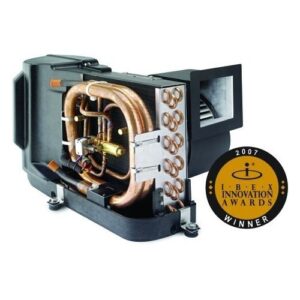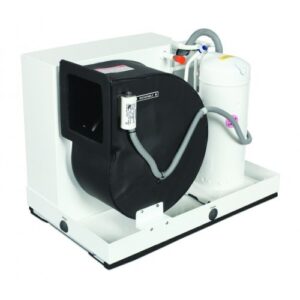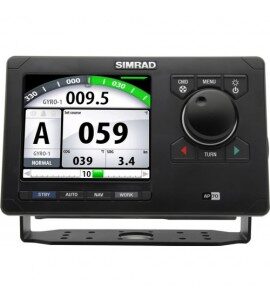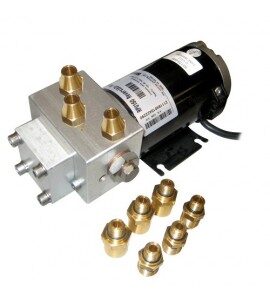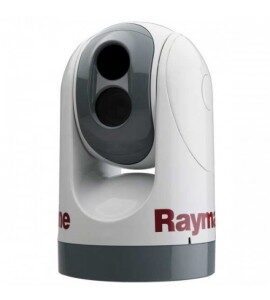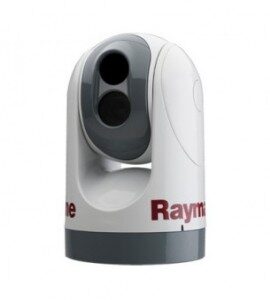Raymarine EV-200 Evolution Autopilot Pack w/ Mechanical Linear Drive
The Evolution autopilot combines Raymarine’s autopilot experience, FLIR Systems’ R & D and advanced aerospace guidance technology to create Evolution Ai control algorithms that provide a new level of precise autopilot control.
Features:
Automagic™ – No lengthy calibration procedures to perform. No compass calibration required. Plug and play connections.
Easy to install – Freedom from the restrictions of conventional heading sensors. EV sensor core can be installed above or below deck. Install upside-down or off the vessel’s center line.
Aerospace technology – 9-axis precision monitoring of pitch, roll, yaw and heading
Fuel efficient – Evolution autopilots steer so accurately they will save fuel and get you to your destination faster.
ACU-200 Control Unit
Specifically designed to complement Type 1 Raymarine Hydraulic, Linear and Rotary Drives, the ACU-200 provides a powerful and secure interface between steering systems and the revolutionary EV-1 course computer and 9-axis sensor.
As a true world-first innovation, the ACU-200 is fully sealed so may be mounted above decks on boats where space is limited.
The rugged ACU (Actuator Control Unit) delivers reliable autopilot drive power and also provides power to the SeaTalkng bus.
The EV1 Sensor Core
At the center of every Evolution system is the intelligent EV sensor core, a 9-axis sensor that monitors vessel motion in all three dimensions. The innovative EV sensor core combines advanced solid-state sensors with the Evolution autopilot processor into a single easy-to-install housing.
Mount the EV sensor core above or below decks, the rugged enclosure is fully sealed and built to IPX6 and IPX7 waterproofing and submersion standards.
The EV-1 is designed for Evolution mechanical and hydraulic autopilot systems.
SeaTalkng networking enables a single cable connection for power and data to the Evolution ACU (actuator control unit) and extended SeaTalkng and NMEA2000 networks.
EV Sensor Core Benefits
Precision monitoring of heading, pitch, roll, and yaw allowing the autopilot to evolve instantly as sea conditions and vessel dynamics change.
Flexible installation options. Mount above or below deck.
Simple SeaTalkng connectivity to the control head and ACU.
Solid state sensor technology delivers dynamic accuracy to within 2 degrees in all conditions.
Auto-compensation for on board magnetic fields and reliable heading accuracy in the northern and southern extremes.
Fast and reliable heading data for MARPA, radar overlay, and heading modes on Raymarine multifunction displays.
This R4 Update Equips The Evolution With The Following Sailor-Friendly Features:
Wind and Vessel Motion: Evolution’s intelligent EV sensor core fuses wind and vessel motion data to better determine true wind conditions
Extremely Stable Steer-to-Wind Angle: Let Evolution steer to a set wind angle, sail downwind, or close hauled without risk of gybing or heading up into the wind
Superior Wind-Shift Detection: Evolution detects and automatically responds to true wind shifts, and prevents unnecessary trimming of sails
Crisp and Efficient Auto Tacking: Evolution filters out the effects of vessel movement for fast and precise Auto Tacking in all sea conditions
Mechanical Linear Drive (Type 1) for Sailing Vessels
The most commonly used drive types for sailing vessels. Raymarine mechanical linear drives provide powerful thrust, fast hard-over times and quiet operation. Mounted below decks, the linear drive moves the rudder directly by pushing the tiller arm or a rudder quadrant.
A linear drive unit connects to the rudder stock via an independent tiller arm. Accessory fittings from your steering manufacturer may be required. Must be able to back-drive steering system from the rudder.
The outstanding design of the Raymarine linear drive unit provides:
Powerful thrust, fast hardover times and quiet operation
Low backdrive force, to minimize the drive’s effect on the boat’s steering when the autopilot is in standby
A powerful electric motor controlled by an electromagnetic fail-safe clutch, using a High tensile belt drive and epicyclic gearbox
High performance for minimum current consumption
The Raymarine P70s is an all weather, low power, optically bonded display that delivers brighter colors, sharper contrast, and a wide viewing angle. Easy to use LightHouse user interface with sculpted rubber keypad allows for precise operation in all conditions.
The p70s is powered by Raymarine’s intuitive LightHouse user interface. which organizes all options into simple menu structures. With The Raymarine Evolution’s Automagic 3-step setup process, you will be up and running in minutes.
Key Features of the P70s
3.5″ diagonal super bright oversized LCD screen for maximum visibility
All weather, low power, optically bonded display technology delivers brighter colors, sharper contrast, and a wide 160° viewing angle
Traditional sailboat interface with -1°, -10°, +1° and +10° course change keys
Supported autopilot modes: Auto; Standby; Pattern; Track; Wind Vane; Power Steer and Jog Steer
Displays the pilot information in different formats with automatic 3-step setup for leisure, cruising and performance
Simple system and group dimming / illumination
Easy to use LightHouse user interface with sculpted rubber keypad for precise operation in all conditions
SeaTalkng networking for seamless connectivity to Raymarine systems and NMEA 2000 networks
Glass bridge industrial design compliments Raymarine eS and gS Series multi-function displays
Supplied with both black (eS Series style) and (e Series style) gunmetal bezels and protective suncover
Evolution Cabling Kit
Raymarine Evolution Autopilots come with the following SeaTalkng cable kit:
Specifications of EV-1 Sensor Core:
Dimensions Diameter: 140 mm (5.5 in) | Depth (including mounting enclosure): 35 mm (1.4 in) | Depth (including wall bracket): 95 mm (3.8 in)
Nominal supply voltage: 12 V (powered by SeaTalkng system)
Operating voltage range: 10.8 V to 15.6 V dc
Power consumption
(taken from SeaTalkngsystem): 30 mA
SeaTalkng LEN
(Load Equivalency Number): 1
Sensors: 3-axis digital accelerometer | 3-axis digital compass | 3-axis gyro digital angular rate sensor
Data connections: SeaTalkng | NMEA 2000 DeviceNet (EV-2 only)
Installation environment: Operating temperature: -20ºC to +55ºC (-4ºF to +131ºF), Storage temperature: -30ºC to +70ºC (-22ºF to +158ºF), Relative humidity: max 93%
Waterproof rating: IPX 6
Weight: 0.29 kg (0.64 lbs)
EMC compliance Europe: 2004/108/EC | Australia and New Zealand
Specifications of ACU-200 Control Unit:
Drive Current Output: Maximum continuous 15 A at supply voltage
Drive Clutch Output: Up to 2.0 A continuous, selectable between 12 /24 V
Connections:
-Rudder reference sensor
-Sleep switch
-Power
-Drive motor
-Drive clutch
-Ground
Nominal Supply Voltage: 12 V or 24 V
Operating voltage range: 10.8 V to 31.2 V dc
Power consumption (standby) – main power supply: 300 mA (12/24 V)
Power consumption (standby) – SeaTalkng power supply: 20 mA (12V)
SeaTalkng LEN
(Load Equivalency Number): 1
SeaTalkng Power out: 3 A at 12 V (fuse protected at 3 A)
Data connections: SeaTalkng
Installation environment:
-Operating temperature: -20ºC to +55ºC (-4ºF to +131ºF)
-Storage temperature: -30ºC to +70ºC (-22ºF to +158ºF)
-Relative humidity: max 93%
Waterproof rating: Drip Resistant
Dimensions: 285 mm x 211.5 mm x 64.5 mm (11.2 in x 8.3 in x 2.5 in)
Weight: 2.2kg (4.84 lbs)
Conformance: Europe: 2004/108/EC
Australia and New Zealand: C-Tick, Compliance Level 2
Maximum boat displacement: 11,000 kg (24,000 lb)
Peak thrust: 295 kg (650 lb)
Maximum stroke: 300 mm (12″)
Hard-over to hard-over times: 11 seconds
Maximum rudder torque: 735 nm (6,500 lb.in)
Power consumption: 18-36 W
Corepack used: ACU-200
Specifications of Type 1 Mechanical Linear Drive
Drive Type: Type 1
Part Number: 12V: M81130
Maximum boat displacement: 11,000 kg (24,000 lb)
Peak thrust: 295 kg (650 lb)
Maximum stroke: 300 mm (12″)
Hard-over to hard-over times: 11 seconds
Maximum rudder torque: 735 nm (6,500 lb.in)
Power consumption: 18-36 W
Corepack used: ACU-200
Specifications of P70s Autopilot Control Head
Display Type: 16-bit Color TFT LCD
Screen Size: 3.45″diag.
Width: 4 3/8″
Height: 4 5/8″
Depth: 1 3/8″
Cutout Size: 3 5/8″dia. x 2 3/16″D w/cable
Horizontal Pixels: 320
Vertical Pixels: 240
Number of Colors: 64,000
Data Interface: SeaTalkng, NMEA 2000,
SeaTalk Voltage: 12V DC
Amperage: 69mA no lighting, 134mA 100% illumination
Waterproof Rating: IPX6 and IPX7
Warranty: Three years (with product registration), Two years without registration



